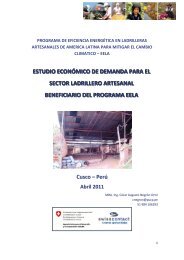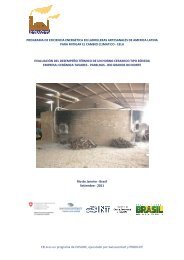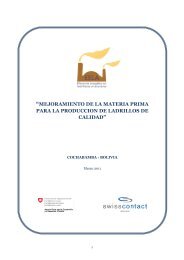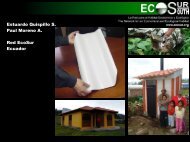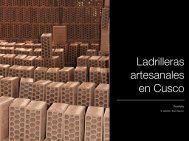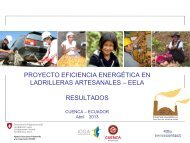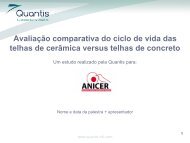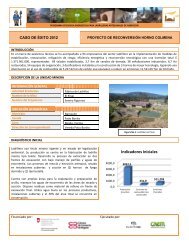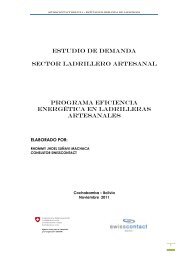A Roadmap for Cleaner Brick Production in India - Red Ladrilleras
A Roadmap for Cleaner Brick Production in India - Red Ladrilleras
A Roadmap for Cleaner Brick Production in India - Red Ladrilleras
- No tags were found...
Create successful ePaper yourself
Turn your PDF publications into a flip-book with our unique Google optimized e-Paper software.
Results of elemental and organic carbon measurements; absorption and s<strong>in</strong>gle scatter<strong>in</strong>galbedo, are shown <strong>in</strong> Table 6.Table 6: Results of Thermo-optical and Light Absorption/Scatter<strong>in</strong>g measurementsTechnologyElemental Carbon(g/kg fired brick)Organic Carbon(g/kg fired brick)Absorption (m 2 /kgfired brick) *S<strong>in</strong>gle Scatter<strong>in</strong>gAlbedo *FCBTK 0.13 0.01 0.22 0.67Zig-zag 0.04 0.02 0.16 0.64 **VSBK 0.002 0.06 0.06 0.77DDK 0.29 0.09 1.13 3.5Tunnel n.d. n.d. n.d. 0.13Notes:The results <strong>for</strong> FCBTK, zig-zag are VSBK are simple average of the three FCBTKs, two zig-zag kilns andtwo VSBK kilns respectively; <strong>for</strong> all the other kiln types, the data is <strong>for</strong> a s<strong>in</strong>gle kiln..n.d. = not detectable (measurement below detection limit)*At red wavelength (660 nm)** Excludes natural draught zig-zag kiln, where scatter<strong>in</strong>g measurements were spurious and may beaffected by measurement error, as the read<strong>in</strong>gs are much higher than expected <strong>for</strong> the measured levels ofparticulate matter.Both tunnel and VSBK had very low BC emissions, as <strong>in</strong>dicated by low value of elementalcarbon and high values <strong>for</strong> s<strong>in</strong>gle scatter<strong>in</strong>g albedo. In the tunnel kiln, the BC emissions werebelow the detection level. The low BC emissions<strong>in</strong> the tunnel and the VSBK can be attributedto the steady-state combustion conditions <strong>in</strong> these kilns and use of <strong>in</strong>ternal fuel.FCBTKsandDDKhad highest BC emissions. In both of these kilns, fuel feed<strong>in</strong>g is <strong>in</strong>termittent, andcombustion conditions show large variation with time. The results show that large BCemissions take place around fuel feed<strong>in</strong>g <strong>in</strong>tervals.Improved combustion conditions <strong>in</strong> zigzagkilns, <strong>in</strong> the <strong>for</strong>m of cont<strong>in</strong>uous feed<strong>in</strong>g of fuel <strong>in</strong> small quantities and better mix<strong>in</strong>g offuel and air,lowered BC emissions compared to FCBTKs.The BC emission factors of brick kilnsmay also be compared with other BC emitt<strong>in</strong>g sources.Figure2compares BC emission factors from this study, with emissions from other types ofcoal combustion and from mobile sources.Emissions from coal combustion can vary widely depend<strong>in</strong>g on the quality of thecombustion. The figure shows that well-operat<strong>in</strong>g power plants, with emission controls, havevery low emissions BC, <strong>in</strong>dustrial stoker boilers have detectable emissions, and heat<strong>in</strong>gstoves – which have no control of emissions or airflow with<strong>in</strong> the stove – have quite highemissions. (Heat<strong>in</strong>g stoves are not used <strong>in</strong> <strong>India</strong>.) The difference <strong>in</strong> emissions is not causedby the fuel, but rather is attributable to the management of the fuel-air mix<strong>in</strong>g and properhandl<strong>in</strong>g of the exhaust products. Emissions of the kilns measured <strong>in</strong> this project fall between14



